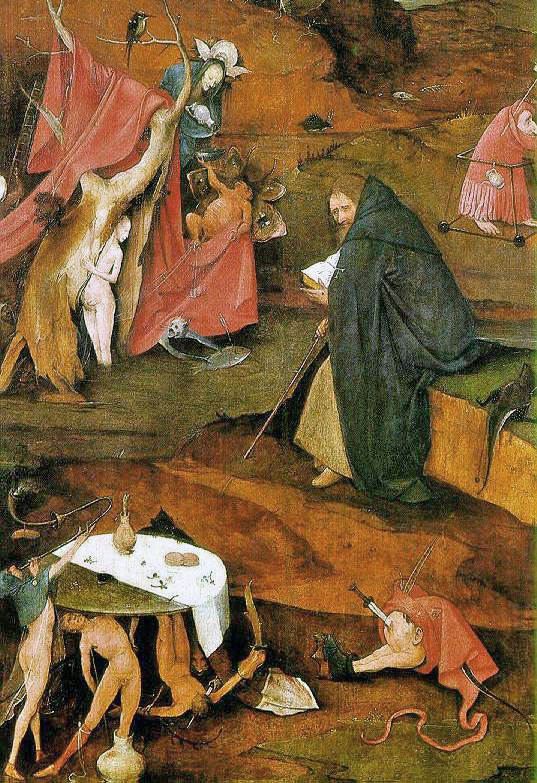

Up: THE SHIP OF FOOLS | Down: ALLEGORY OF INTEMPERANCE
Hieronymus Bosch (1450-1516)
Left wing of an altarpiece
ca. 1495-1500
Oil on panel, 58 x 33 cm
Musée du Louvre, Paris | Yale University, New Haven
The Ship of Fools comes from the left-hand part of a triptych whose central panel has been lost. Cut at its base, the Louvre’s piece fits perfectly onto another fragment kept at Yale University Art Gallery in New Haven (its title, Allegory of Intemperance, is more a reference to drunkenness and lust).
It is likely that The Ship of Fools, which depicts characters who are drunken, shameless and obsessed by food and drink, is a satire on monks (represented by the figure in the foreground) and an ironic criticism of the drunkenness costing them both their senses and their souls. Anger, caused by too much drinking, would explain why the woman is hitting the young man with her pitcher. An assembly of gluttons and drunks are being swept towards their doom like fools. In this way, the dissolute clergy, by neglecting the saving of souls, are leaving the Church’s ship adrift. This viewpoint, representing criticisms made later during the Reformation, appears to be illustrated by the man hanging desperately onto the ship, ignored by its passengers. (Source: Press dossier, Louvre).
The intimate link between gluttony and lust in the medieval moral system is expressed by Bosch in the Yale fragment, Allegory of Intemperance. Gluttony is personified by the swimmers at the top right: you can see them gathered around a large barrel, which is ridden by a big-bellied peasant. Another man is shown swimming closer to the shore, his vision obscured by the meat pie that he is balancing on his head. This scene is observed by a couple (of lovers?) on the right, who are sheltering in a tent. It is completely appropriate that the pair are drinking wine: “Sine Cecere et Libero friget Venus”. This quotation, from the Latin poet Terence (ca. 185-160 BC) was well-known in the Middle Ages: “Without Ceres or Bacchus, Venus catches cold.” In other words, without food or wine, love grows cold. In Roman mythology, Ceres is the goddess of agriculture, harvests and fertility. The moralisers of Bosch’s time never tired of reminding people that gluttony and drunkenness led directly to lust.
Why was Bosch’s panel cut in two? What was the motive behind this crime? Nothing proves it, but it seems obvious: the “criminal” would have earned more from selling two paintings than just one, especially given that Hieronymous Bosch didn’t always sign his work. This practice was not rare among “antiques dealers” of the time, meaning sellers of paintings. The juxtaposition of these two fragments allows us to reconstruct the panel of a small triptych. The opposite wing, kept at the National Gallery of Art in Washington, D.C. and traditionally known as Death and the Miser, depicts the sins of envy and avarice. In short, this triptych showed the errors of a human race guided by vice and materialism.
.jpg)
DEATH AND THE MISER
Hieronymus Bosch (1450-1516)
Back left wing of an altarpiece
ca. 1485/90
Oil on panel, 93 x 31 cm
National Gallery of Art, Washington, DC
In this panel Bosch shows us the last moments in the life of a miser, just before his eternal fate is decided. A little monster peeping out from under the bed–curtains tempts the miser with a bag of gold, while an angel kneeling at the right encourages him to acknowledge the crucifix in the window. Death, holding an arrow, enters at the left. This type of deathbed scene derives from an early printed book (before 1501, an incunabulum), the Ars Moriendi or Art of Dying, which enjoyed great popularity in the second half of the fifteenth century.
A FEW MORE EXHIBITED BOSCH'S PAINTINGS, EXHIBITED OR NOT*

Marriage Feast at Cana ca. 1475/80 - Boijmans Van Beuningen, Rotterdam, The Netherlands

* Saint Christopher ca. 1496-1505 - Boijmans Van Beuningen, Rotterdam, The Netherlands

Temptations of Saint Anthony, crop Right panel), ca. 1501 - Museu Nacional de Arte Antiga, Lisbon, Portugal
> Click on the icons for a closer look at the artworks

